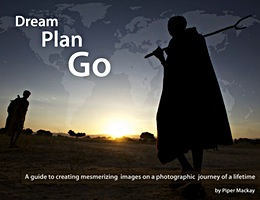
This past February, after the Incredible India Tour, a few photographers joined me in Ranthambore for a Tiger Safari. At the moment we entered the park, we immediately had a Tiger sighting! We had 12 sightings in two days, nearly a record, and it was thrilling beyond expectations.
It had been about a decade since my one-day visit to Ranthambore where I had two fleeting sightings in which I had carried my 500 with me for 21 days, just in case the ultimate opportunity presented itself. A decade back, very few people offered Tiger photographic safaris, because the rules were stringent making it difficult, if not impossible, to find them, and they were just gaining ground in Tiger conservation. However, this time I did not leave it to chance. I teamed up with one of the most talented Tiger photographers in India and stacked the deck in our favor.
Almost every wildlife photographer around the world ascends on the Massai Mara during the migration season. As luck would have it, one of the most talented Tiger photographers in India always stays in the same camp I use, but our paths did not cross until about three years ago, when we started scheming about teaming up for safaris in India. I was already a fan of his work and dedication and after many conversations, usually over a cold Tusker, so I knew I was working with someone with vast knowledge of India’s reserves who was well connected.
Even so, after specializing in photographing African wildlife in the most renowned reserves in the world for more than a decade, I have to admit that I was skeptical that an Indian Tiger safari could come close to the excitement that seems to be around every corner on an African Safari, regardless of their gain in popularity over the past few years. I also had the preconceived judgment from listening to others. As many of you may have also heard, Tigers are allegedly very difficult to find, and many people leave without seeing one. And there you have it – my short-sightedness in even trying to compare the experiences, both of which are spectacular!
It was so vastly different from most African wildlife safaris! What I loved most was the Authentic approach – there are no radios announcing every sighting. We had to depend on the skills of the naturalist, the driver, and Shivang to track the Tiger by understanding their territories and behavior, as well as finding the paw prints and listening to the warning calls ringing throughout the jungle. Yes, a good team is still resourceful by having a sophisticated system communicating across a network of fellow rangers, colleagues they pass in route, and maybe using their cell phones if there is any signal. Nonetheless, there is no denying the importance of their experience and skills.
We would be zipping along the dusty tracks, the ground blurring quickly by us, but our team seemed to be able to autofocus on every track. They would study the sharpness, size of the paw, shape of the nails, and would tell us the sex, if it were a sub-adult, and when it was last there by the depth of the impression. We would then continue driving along and then suddenly just stop. In Africa, this would surely mean to pull out your camera as obviously something has been spotted, but on a Tiger safari, it means one should become quiet, as the team crocks their well-trained ears to listen to the slightest hint of sound in the distance. Many times we would sit for up to a half hour, surrounded by the beauty of nature, when the alarm call would sound and we would race off with our hearts pounding.

Beyond an incredibly skilled and experienced team, one must also have a lot of luck, which is why it is important to stack the deck in your favor; exactly what we did by securing all-day full-access permits. These permits are extremely limited and are booked well in advance, but they are key, as they give you access to all the zones in the park with unlimited time in the park while it is open. What many people do not know is that most parks are divided into zones with a maximum amount of vehicles allowed per zone. The vehicles line up at the gate and are assigned one zone even when several of the zones may not have had a sighting or any tiger activity in months. Also, most parks require vehicles to exit the park from 10:00 – 3:00 and many times this is prime Tiger viewing time, as they are moving to the water sources during the heat of the day. It is not unusual to find them in the water, cooling off. Therefore, as I would say to my group, with a big grin, “it is important to have the Keys to the Kingdom” – keys to unlock the gate to each zone and the permission to be there!

I am already excited about our Tiger and wildlife Safari next year and hope to offer it again in 2020.
Later in the week, Shivang and I went on down to Corbett; India’s oldest reserve and one of the most beautiful. Even if I had not seen the elephants or Tigers it would have been incredible.
View more image of Indian Tigers and Wildlife














